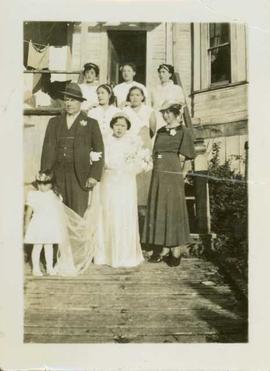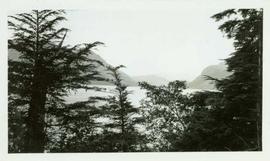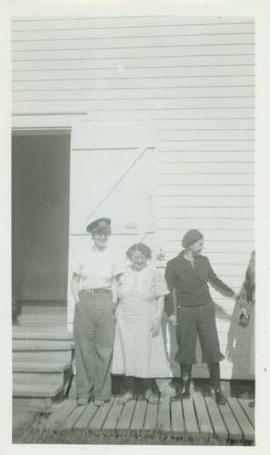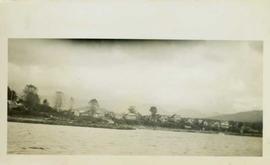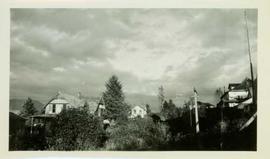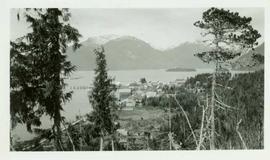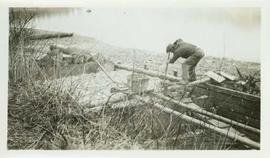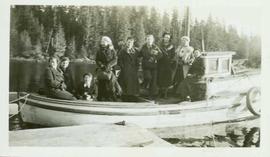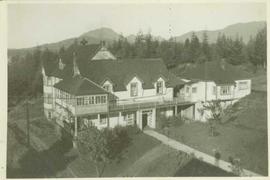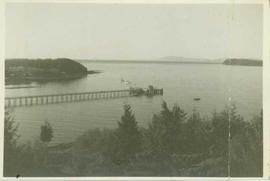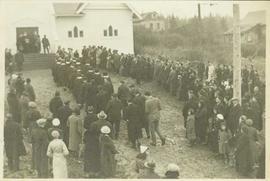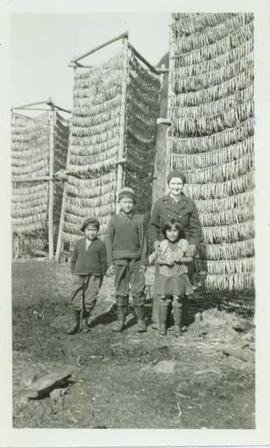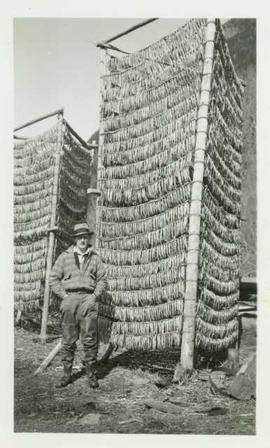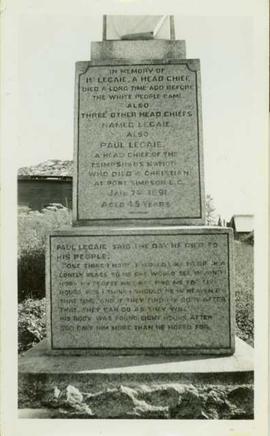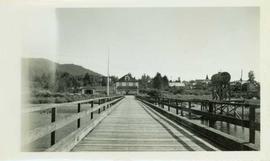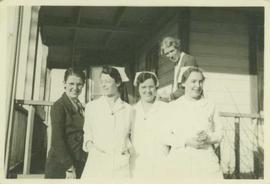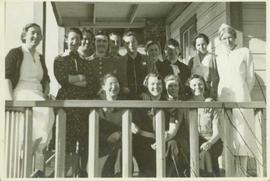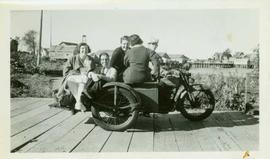Group photo featuring a young First Nations bride, her father, flower girl and attendants in front of a house just before leaving for the Church.
Handwritten annotation on verso reads: "A Native bride leaving her home with some of her attendants on the way to the church. At the ceremony in the church she had 14 tendants (sic) & 14 men."
Scenic landscape featuring mountains and water in background and treetops in foreground. Handwritten annotation on verso reads: "View of Bay from Hospital which was high upon a hill."
Three women, two wearing hats and pants and one in a dress, stand together in front of what is possibly the Hudson's Bay Store. The woman on the left is Mrs. Huston, wife of the Hudson's Bay Company store manager. Handwritten annotation on verso reads: "Light House caretakers, wife in centre, Lady with cap on, wife of ....the Hudson Bay Store at 1932 ."
Subject areas identified in this collection include: church and hospital buildings (including nurses quarters); group photos featuring doctors, nurses, and hospital workers; grave markers; landscapes; processing of oolichan fish; and various church-related events such as weddings and church openings.
Thomas Crosby Mission ShipsHandwritten annotation on verso reads: "Port Simpson Village threatening storm in background."
Handwritten annotation on verso reads: "A storm brewing over Port Simpson."
Scenic landscape featuring Port Simpson village framed by mountains, water and tree tops. Handwritten annotation on verso reads: "View of the Port Simpson Bay & some of the village."
Unidentified man stands on a log while spreading fish across beach with a poll in preparation for boiling. Handwritten annotation on verso reads: "Ooligans spread over the beach ready to go into the boiling tanks, near the Nass River, 1932."
Ten women sitting or standing in a fishing boat at dock. Handwritten annotation on verso reads: "Nurses & school teachers of Port Simpson on a trip to a Light House. Lady at Light House really thrilled to see so many women. Hadent (sic) been away from Light House for 6 months, 1932".
Handwritten annotation on verso reads: "Port Simpson Hospital & Nurses residence. The peaked roof at the back was the laundry shed, we had a badminton court in there."
Perspective of the harbour as seen from the top of a nearby mountain. Handwritten annotation on verso reads: "Port Simpson Harbour."
Clergy standing at the entryway to the newly reconstructed church as the choir walks towards them in two lines. The attendant congregation watches. The original Grace Methodist Church had been dedicated in the late 1800s and had its name changed to Grace United Church with Church Union in 1925; it was destroyed by fire, however, in 1931. Handwritten annotation on verso reads: "Opening of new church 1938."
Clergy standing at the entryway to Grace United Church speaking to a crowd gathered to witness the opening of this newly reconstructed church. The original Grace Methodist Church had been dedicated in the late 1800s and had its name changed to Grace United Church with Church Union in 1925; it was destroyed by fire, however, in 1931. Handwritten annotation on verso reads: "Opening of new church 1938. The left hand row of people with the white collars were the P.S. Choir. The right hand row was the band & Chair from Metlakatla, Alaska."
Handwritten annotation on verso reads: "Ooligans hung for drying, Mrs. Huston, and some Native children, near the Nass River, 1932."
Handwritten annotation on verso reads: "Ooligans hung for drying, near the Nass River. Mr. Huston, manager of the Hudson Bay Store, Port Simpson, 1932."
Handwritten annotation on verso reads: "Native Lucaie (aka: Legaic or Ligeex) Head Chief at Pt. Simpson, tomb stone on the beach." Text on headstone reads: "In memory of First Lecaie, A Head Chief, died a long time ago before the white people came, also three other Head Chiefs named Lecaie, also Paul Lecaie a Head chief of the Tsimpshans Nation who died a Christian by at Port Simpson, B.C. Jan 7, 1891, Aged 45 years. Paul Lecaie said the day he died to his people: 'One thing I hope, I would die in a lonely place, so no one would see me and I hope my people will not find me for five hours, for I think I should be in Heaven by that time and if they find my body after that...they can do as they will.' His body was found 8 hours after God gave him more than he hoped for.”
Hudson's Bay Company store visible at the end of a long wharf. Handwritten annotation on verso reads: "Hudson Bay store at end of wharf, Port Simpson, 1932 ."
Handwritten annotation on verso reads: "Front row: Miss Lydia Farrow, ? , Ena Complice (?), Miss Grace Mercer, Miss Grace Bedford matron. The lady at the back is Miss Grace Bedford who had been a missionary in China for many years, also at Erickson, Manitoba then here at Port Simpson."
Fourteen women pose for a photo on the veranda of the Port Simpson Hospital(?). Handwritten annotation on verso reads: "Entire female population of Port Simpson in early thirties."
Handwritten annotation on verso reads: "The only car in Port Simson (sic), used for bringing mail & Hudson Bay Store supplies, 1932."
Handwritten annotation on verso reads: "In the foreground is the boiling tanks for the ooligans. A fire is lit in the tanks then big stones heated red hot. When the water becomes boiling hot then the ooligans are shoveled in & left over night. During the night, skin & bones settle to bottom & fat comes to the top. Then with a board the width of the tank, pails hung on a spout at the end of the tank, and fat is scraped into the pails and used for butter. In the background is the smokehouse."
